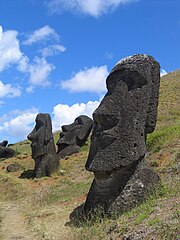
1720s in archaeology
(Redirected from 1723 in archaeology)

| 1710s . 1720s in archaeology . 1730s |
| Other topics: N/A |
| |||
|---|---|---|---|
| +... |
The decade of the 1720s in archaeology involved some significant events.

Explorations
- 1722: Dutch explorer Jacob Roggeveen arrives at Easter Island.
Excavations
- Formal excavations continue at Pompeii.

Finds
- 1723: Roman inscribed stone found in Chichester, England.
- 1725: Rudge Cup found in England.
- 1727: Gilt bronze head from cult statue of Sulis Minerva from the Temple at Bath, England, found by workmen excavating a sewer.
Publications
- 1723: Antoine de Jussieu publishes De l'Origine et des usages de la Pierre de Foudre on the origins of fossils, prehistoric stone tools and meteorites.[1]
Births
- 1721: Nicholas Revett (d. 1804)
- 1726: October 12 - Pierre Henri Larcher (d. 1812)
- 1729: 25 September - Christian Gottlob Heyne, German archaeologist (d. 1812)
References
- ^ "Les pierres de foudre". Retrieved 2011-10-18.
See what we do next...
OR
By submitting your email or phone number, you're giving mschf permission to send you email and/or recurring marketing texts. Data rates may apply. Text stop to cancel, help for help.
Success: You're subscribed now !
